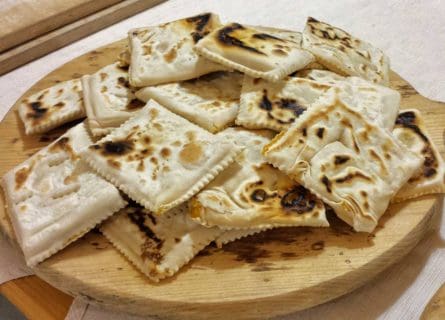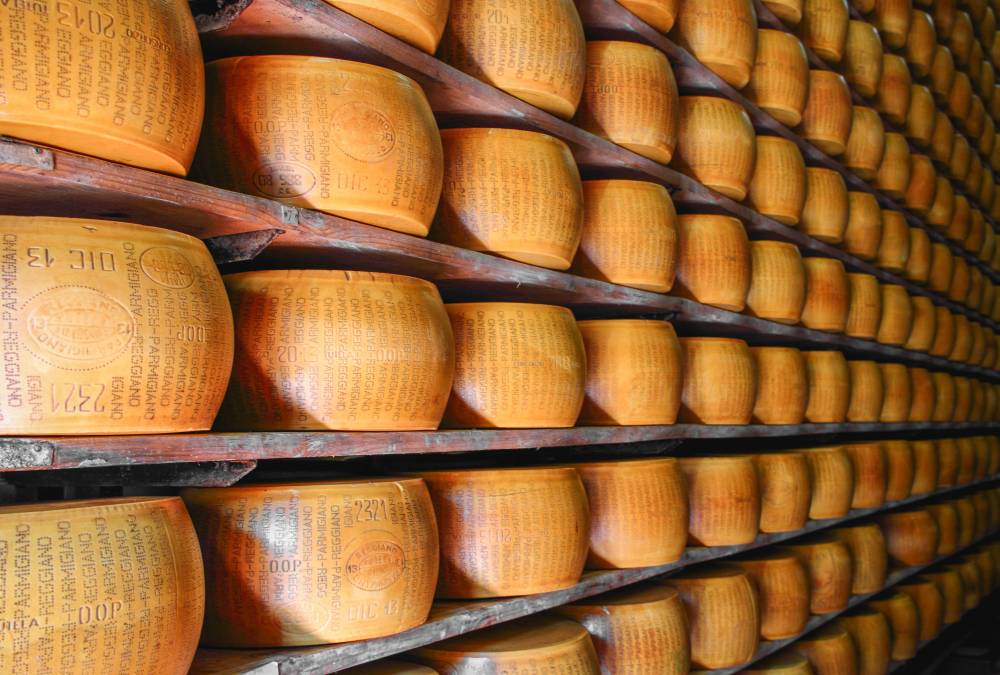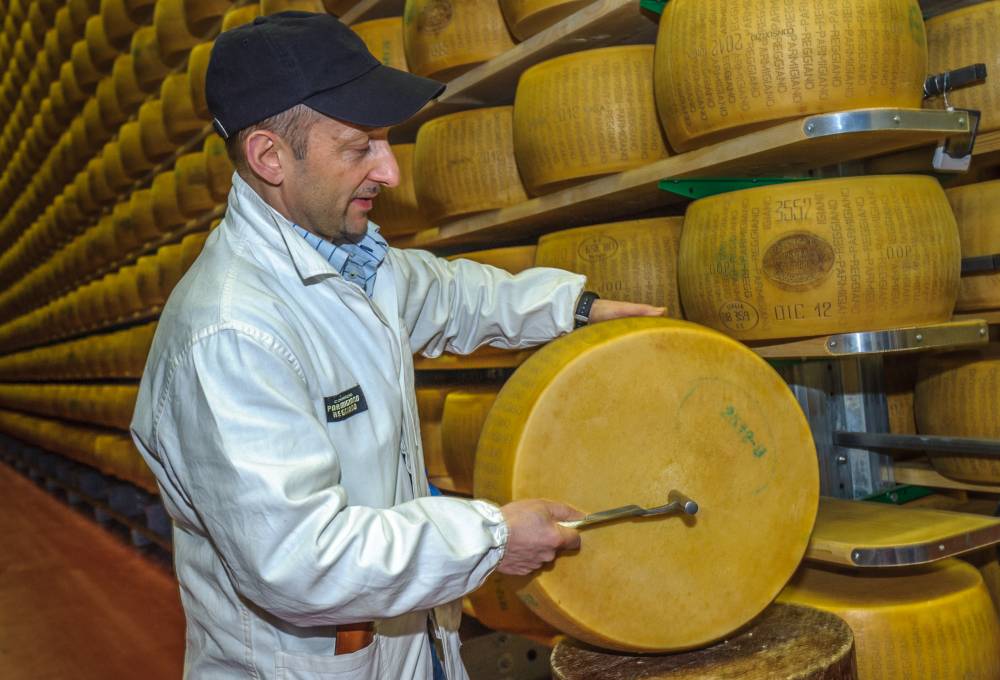
A Taste of Forlí-Cesena: Discovering Authentic Emilia-Romagna Cuisine
November 18, 2023
Explore Forlí-Cesena's culinary treasures in our guide. Discover Emilia Romagna's authentic flavors, from wines to artisanal cheeses. A must-read for foodies!
By: Sarah Lane / Last updated: April 27, 2024
Estimated reading time: 7 minutes
Known for a good reason as the King of Cheeses, Parmigiano Reggiano is a major protagonist at dinner tables worldwide. Although little has changed since it was first produced over a thousand years ago, its popularity, versatility, and relevance to current-day dinner tables have never been greater.

We owe a lot of thanks to the medieval monks for the farming systems they developed, which allowed for the production of wines, spirits, and delicious foods, including Parmigiano Reggiano. As self-sufficient farmers, the Benedictine and Cistercian monks of the Parma region invented a way of preserving cheeses made with the milk from their large herds of cattle by using salt from the nearby spa town of Salsomaggiore. Over time the technique caught on, and soon there were sharecropping systems, forerunners of today’s Parmigiano Reggiano cooperatives; Boccaccio mentioned the cheese in his celebrated 14th-century work, ‘Decameron,’ and by Renaissance times, the famous cheese was being exported far and wide.
The aura of wonder surrounding Parmigiano Reggiano is only perhaps heightened by its strict system of checks and controls; yet, for such a mighty cheese, the production method and ingredients list are astonishingly simple.
The official area for Parmigiano Reggiano production is small, covering the provinces of Parma, Reggio Emilia, and Modena, together with a small part of western Bologna in Emilia Romagna, plus a sliver of Mantua province (the region south of the River Po) in Lombardy. All the milk must come from this area, and the cows’ diet is carefully regulated: the grass or hay they eat is grown in the region, and silage (preserved hay) is prohibited.
Visiting a cheese dairy often means an early start – cheesemaking occurs as soon as the milk arrives from the milking parlors. Full fat and raw, the fresh morning milk is combined with the milk from the previous evening, from which the cream is skimmed off after resting in wide tanks. The resulting semi-skimmed milk is poured into large, upside-down bell-shaped copper-lined vats – around 550 liters for each wheel, over 1000 liters per vat. All that’s added, apart from a small amount of whey starter from the previous day’s cheesemaking, is natural rennet. Heated by steam passing through the walls of the vats, the milk curdles, and the curds are broken using a long-handled implement rather like a globe-shaped rake, known as ‘spino’ from the Italian word for hawthorn, biancospino, the branches of which were once used. The process continues with further heating to 55°C, and the coagulated mass of cheese is divided into a pair of ‘twins,’ each weighing around 50kg. These two wheels are heaved out using traditional linen cloth and placed in a circular mold with the characteristic dotted ‘Parmigiano Reggiano’ script around the edge for a couple of days. Some of the remaining whey is used for ricotta, though much of it is fed to pigs, contributing to the excellent local pork-based products.
The next stage for the cheeses is a three-week bath in salted water; they are then ready to begin their long aging process resting on shelves and rotated regularly for a minimum of 12 months.
Once a year has passed, the Consortium visits, and an expert tests each wheel, tapping it with a small hammer and listening for defects such as air pockets. Those that pass the test receive the hot-iron branded oval Parmigiano Reggiano logo. Those who do not pass the test are scored with a series of parallel lines around the entire edge of the wheel and sold as ‘mezzano’ (medium-quality cheese).

Testing the cheese for defects with a special hammer
The premium quality cheeses may continue aging beyond twelve months for a further year or more. Although some producers are now experimenting with extreme aging, it’s becoming easier to find Parmigiano Reggiano of up to 48 or 60 months.
Traceability is key when such heights of excellence are involved. Each wheel bears an edible casein QR code that references the milk’s origin, the exact cheesemaking vat, and the date. Furthermore, a serial number identifying the dairy farm and the production date is stamped onto the edge of the cheese.
While any breed of cow can produce milk for Parmigiano Reggiano, the majority are the high-yielding Italian Friesians, the black and white cattle originally from the Dutch district of Friesland. Some producers, however, still use traditional local cattle, such as the white Bianca Modenese, a Slow Food protected breed, the mushroom-colored Bruna, or the rusty-red coated Vacca Rossa of Reggio Emilia. Producers adhering to the Vacche Rosse consortium must make their Parmigiano Reggiano using milk that comes exclusively from this breed; their cheeses generally display a more creamy texture and must age for a minimum of 24 months.
Parmigiano Reggiano, made in mountain areas, where the cows enjoy high-altitude pastures and natural biodiversity, can bear the green mark of the ‘Prodotto di Montagna’ certification. This cheese is generally less salty than its counterparts from the plains below and is subject to additional regulations.
While many of us grate Parmigiano Reggiano over pasta, there are myriad other ways to enjoy it. Naturally rich in vitamins and nutrients, the cheese is lactose-free by the time it’s released. Over time, it evolves and matures, developing deeper colors, drier textures, and richer, mellow flavors that make it a perfect match for different pairings or uses in the kitchen. The younger cheeses (12-18 months) make a delicious accompaniment to aperitifs, salads, and fresh fruits; at 24 months, the cheese’s expressive character works well with pasta dishes and vegetable soups. Older-aged Parmigiano Reggiano (30 months and above) is a good partner for meat or fish recipes, as a snack with walnuts or almonds, or simply with a well-structured red wine or a few drops of traditional balsamic vinegar.
When you’ve eaten your way down to the rind, don’t despair, it’s perfectly edible, as a natural part of the cheese that has hardened over time due to contact with the atmosphere – there is no artificial coating. In addition, the rind of Parmigiano Reggiano can add a delicious extra something to soups and stews; the cooking process softens even the toughest rinds so that you can eat that too. Check out our Emilia Romagna Cuisine guide for more on the region’s culinary treasures.
A visit to a working cheese dairy is a fascinating way to experience Parmigiano Reggiano. If you’re lucky enough to witness the first opening of a wheel of cheese, it’s a memorable experience. Cellar Tours has designed an Italian Gourmet Grand Tour with VIP visits to top parmesan artisan producers in Emilia Romagna.
The Parmigiano Reggiano website has a wealth of information on their prized product and a collection of recipes and tips for cooking with it.
For more on the background and history of the cheese, visit the fascinating Parmigiano Reggiano Museum near Parma. It is a fascinating foodie-themed museum in the Parma area housed in a circular brick-built cheese dairy dating from the mid-19th century.
If you would like us to customize an exclusive luxury tour, contact us and let us know your travel plans. We offer luxury food and wine tours for private groups of a minimum two guests. In addition, all of our private, chauffeured tours are available year-round upon request.

